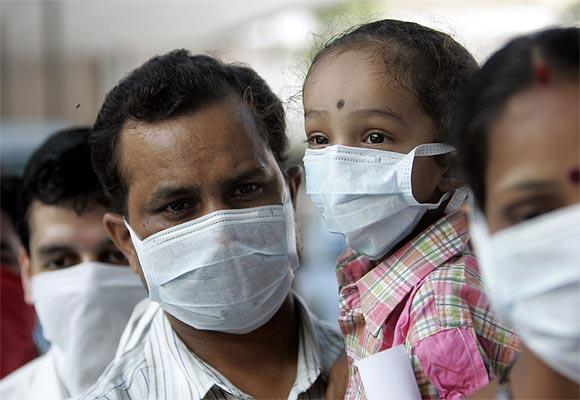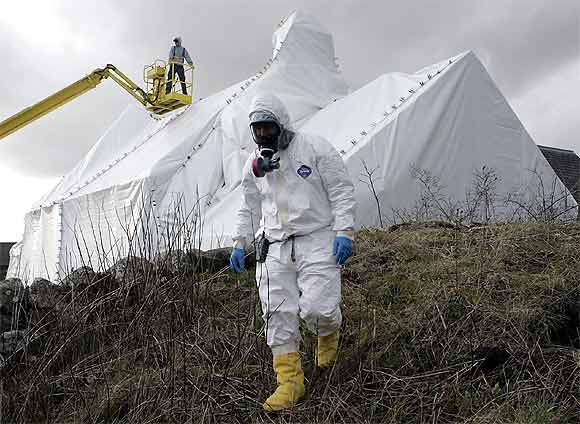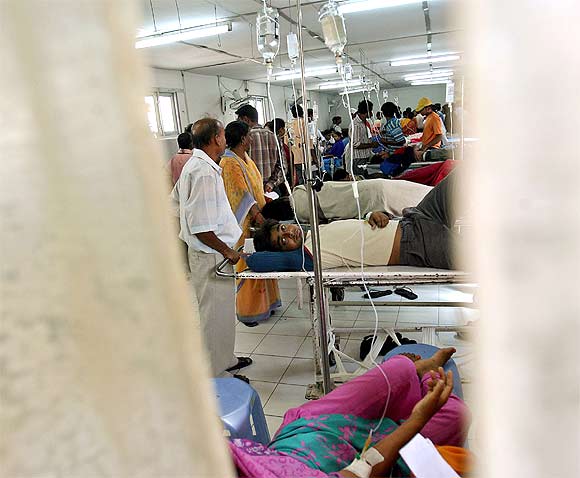 | « Back to article | Print this article |
India is NOT READY to face this terror threat
Lack of preparation, coupled with the pathetic state of healthcare, make India highly vulnerable to the threat of bio-terrorism, says Vicky Nanjappa
In 1996, a major outbreak of dengue hemorrhagic fever had shaken India. The situation was brought under control soon but authorities have not been able to find out how the virus entered India.
Was it a case of bio terrorism? Nobody has an answer.
Today, we debate on ways to tackle sea borne attacks, aerial attacks, jihadi strikes and bomb blasts. Do we take the threat of bio-terrorism seriously enough?
According to reports by intelligence agencies, bio-terrorism is a very real threat and Pakistan-based jihadi groups are capable of launching such an attack. But terror outfits are not prepared to use such a deadly form of attack.
India is NOT READY to face this terror threat
"We have information about plants in both Afghanistan and Pakistan aimed at carrying out bio-terrorism. They (terror outfits) lack the required expertise and they are trying to find specialists who can create the required infrastructure," said a source in the Intelligence Bureau.
Once they perfect the technique, terror outfits are likely to unleash bio-terrorism on an unsuspecting world, as it is deadlier compared to chemical warfare. It is capable of causing a greater degree of devastation which will last longer.
Not surprisingly, India doesn't really have a game-plan in place to tackle such an attack. The outbreaks of certain deadly diseases have always been attributed to natural causes and authorities have never tried to find out which factors had caused them.
India is NOT READY to face this terror threat
According to security experts, there is an urgent need to set up a disease surveillance network in India. Despite several proposals, no concrete action has been taken to set up such a network.
While a sense of bravado will motivate terror groups to take on their 'enemies' on the ground for the time being, bio-terrorism may turn out to be the deadliest weapon of the future.
The Union home ministry of India has held several top-level meetings to seriously discuss the issue. Specifically, the authorities discussed the anthrax scare, which had terrorised United States after the 9/11 attacks.
A report by the home ministry warns that bio-terrorism can wreck devastation by targeting even agricultural crop.
India is NOT READY to face this terror threat
The report, quoted in the recently released WikiLeaks cables, indicates that India faces a serious threat as terror outfits based in Pakistan have shown signs of expanding their capabilities, especially in the bio-technology sector.
Lack of preparation, coupled with the pathetic state of health care, makes India highly vulnerable to such a strike.
According to Indian agencies, only major terror outfits like Al Qaeda and the Lashkar-e-Tayiba have the capability to carry out such warfare.
Last year, it was pointed out that the Al Qaeda was raising funds for an attack. These terror groups would need a large number of recruits to carry out such an attack and they had reportedly recruited nearly 800 women for the job.
India is NOT READY to face this terror threat
Instances of terror groups setting up laboratories for such warfare date back to the 1990s. The first such laboratory was set up at Kandahar in Afghanistan. Security agencies fear that the same could be used to launch attacks in other parts of the world, including India.
While the laboratory at Khandahar is under the control of the Al Qaeda currently, the one at Muzaffarabad in Pakistan-Occupied-Kashmir is currently under the control of the LeT.
According to intelligence reports, terror outfits today have the capability to unleash diseases like tick-borne hemorrhagic fever viruses and yellow fever, to target humans as well as agricultural crops.



